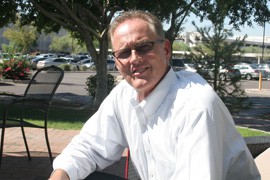Cronkite News has moved to a new home at cronkitenews.azpbs.org. Use this site to search archives from 2011 to May 2015. You can search the new site for current stories.
Organizer ready to try again to create top-two primary system
PHOENIX– With independents now the state’s largest voting bloc, former Phoenix Mayor Paul Johnson said he’s getting ready for another attempt at establishing primary elections that have the top two vote-getters advancing regardless of party.
“I think it’s a process of when you’re asking for change it never happens on the first time,” Johnson said. “You have to keep going back.”
Voters overwhelmingly defeated the idea in 2012. The state Republican, Libertarian and Green parties opposed Proposition 121, while the Arizona Democratic Party didn’t take a stand but made its concerns clear. Meanwhile, the campaign against the measure was funded in large part by hundreds of thousands of dollars from a conservative dark money group.
Supporters of so-called top-two primaries point to low participation in primary elections by independents, who must choose one party’s ballot, and contend that opening primaries would increase turnout by independents and lead to more moderate candidates advancing to the general election.
Washington implemented such a system in 2008, followed by California in 2012. Louisiana has had a top-two primary system since 1975 – though there a candidate winning more than 50 percent wins outright – but it went back to partisan primaries for congressional offices in 2008.
Johnson, who is aiming to put the issue back on the ballot in 2016, said keeping things they way they are favors the two major parties.
“They’re doing the best they can to keep independents out of voting in primaries, and what’s worse is that parties are controlled by their extreme groups,” he said. “How do we change that?”
Grady Gammage Jr., a senior fellow at Arizona State University’s Morrison Institute for Public Policy who helped draft Proposition 121, said he was motivated by the fact that independents are largely disenfranchised in the primary election process.
“I think if you empower independents to vote it will further the democratic shift,” he said. “Inevitably it will create change and more of a move to the middle of the spectrum.”
Gammage attributed the 2012 defeat to pushing the initiative too late and the lengthy legal battle required to get Proposition 121 on the ballot after the Secretary of State’s Office disqualified about 100,000 petition signatures. He said success in 2016 would require more money than was behind the 2012 measure.
“There has to be a significant amount of money that is pledged from the outset, and that probably means going to a small number of people who are interested in this cause and raising several million dollars to push it,” he said. “This will create backlash with just four or five people contributing, but there’s no alternative when you have parties against you.”
DJ Quinlan, executive director of the Arizona Democratic Party, said that while the party hasn’t taken a formal stand on top-two primaries it’s worth noting that not much has changed in California.
“You see a high number of incumbents elected and still a huge amount of loyalty to both parties,” he said. “I think the key point is people are well intentioned, their goal is to enhance the voice of independents, but when you really look at these independents they’re not engaged because they never have been.”
Tim Sifert, communications director for the Arizona Republican Party, said Arizonans made their wishes clear in 2012.
“Most voters rely on party identification for guidance and choosing candidates,” he said. “They just said ‘no’ last time, and we really don’t think voters are going to be enthusiastic about seeing it again.”
Joe Cobb, treasurer of the Arizona Libertarian Party, said a top-two primary system would effectively remove third-party candidates from the general election ballot and that voter participation would in fact drop. In the end, he said, the general election would involve the candidates with the most money.
“The situation of the truly independent person is that they’re much further out of the picture in the top-two,” he said. “It excludes them even though it pretends to be more democratic.”
Kristin Borns, an independent public policy analyst, said voters are inclined to trust a primary system in which party identification is outlined but said it would be unwise to discount the possibility of a top-two primary succeeding in 2016.
“Arizona has always been this sort of push and pull, with progressive initiatives here and there,” she said. “There’s always been a perception that where voters are at may not necessarily be where our legislators are at and polls have showed there is definite interest in this.”







